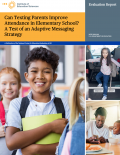
Student engagement is multi-faceted, characterized by behavioral, emotional, and cognitive engagement.
Student engagement is a key element of a positive school climate, with a large body of research linking it to academic achievement. Students demonstrate behavioral engagement through actions such as consistent attendance, completing assignments, coming to class prepared, and participating in class and in school activities.
Students are emotionally engaged when they like school, are interested in, and identify with school culture. Students are cognitively engaged when they exert effort to do well in school, which can lead to strong academic self-concept.
Students’ feelings of connectedness refer to students’ sense of belonging at school, which is fostered through relationships with other students and staff that are respectful, trusting, supportive, and caring. Research shows that connectedness, particularly between students and teachers, related significantly to engagement and academic outcomes, including school attendance, grade point average (GPA), rate of suspension, and test scores. Students consistently report feeling more motivated and more confident in completing their schoolwork when they feel that their teachers care about and support them.
Conversely, students who feel disconnected from their teachers and their academically engaged peers often fail several courses, drop out of high school often, or demonstrate a lack of participation in school. Nearly half the dropouts surveyed in a national poll said the main reason they left school was because classes were not interesting. Almost seventy percent of students surveyed cited not feeling motivated to work hard, and that low expectations held by adults in schools, along with low academic standards, discouraged them from working hard.
A study of Chicago Public Schools found that connectedness between teachers and students was a stronger predictor of students feeling safe within school than the poverty level of students or the crime rate of the neighborhoods where students live.9 Research using nationally representative data also suggests that positive student-teacher relationships predict fewer incidences of misbehavior and violence in school
In particular, service learning programs and other types of experiential learning can help disengaged students connect to learning.
Akey, T. M. (2006). School context, student attitudes and behavior, and academic achievement: An exploratory analysis: MDRC.
Allen, K. A., Jamshidi, N., Berger, E. et al. Impact of School-Based Interventions for Building School Belonging in Adolescence: a Systematic Review. Educ Psychol Rev (2021). https://doi.org/10.1007/s10648-021-09621-w
Bridgeland, J. M., DiIulio, J. J., & Morison, K. B. (2006). The Silent Epidemic: Perspectives of High School Dropouts. Washington, DC: Civic Enterprises.
Corcoran, R. P., Cheung, A. C. K., Kim, E., & Xie, C. (2018). Effective universal school-based social and emotional learning programs for improving academic achievement: A systematic review and meta-analysis of 50 years of research. Educational Research Review, 25, 56-72, DOI: 10.1016/j.edurev.2017.12.001
Fenzel, M. L., & O’Brennan, L. M. (2007). Educating at-risk urban African American children: The effects of school climate on motivation and academic achievement. Paper presented at the annual meeting of the American Educational Research Association.
Fredricks, J. A., Blumenfeld, P. C., Friedel, J., & Paris, A. H. (2005). School Engagement. In K. A. Moore & L. Lippman (Eds.), What do Children Need to Flourish: Conceptualizing and Measuring Indicators of Positive Development. New York: Springer.
H. Korpershoek, E. T. Canrinus, M. Fokkens-Bruinsma & H. de Boer (2020) The relationships between school belonging and students’ motivational, social-emotional, behavioural, and academic outcomes in secondary education: a meta-analytic review, Research Papers in Education, 35:6, 641-680, DOI: 10.1080/02671522.2019.1615116
Lee, V., Smith, J., Perry, T., & Smylie, M. A. (1999). Social support, academic press, and student achievement: A view from the middle grades in Chicago. Chicago: Consortium on Chicago School Research.
Kendziora, K., Osher, D., & Chinen, M. (2008). Student connection research: Final narrative report to the Spencer Foundation. Washington, DC: American Institutes for Research
Klem, A., & Connell, J. (2004). Relationships matter: Linking teacher support to student engagement and achievement. Journal of School Health, 74, 262-273.
McNeely, C. A., Nonnemaker, J. M., & Blum, R. W. (2002). Promoting student connectedness to school: Evidence from the National Longitudinal Study of Adolescent Health. Journal of School Health, 72(4), 138-146.
Osher, D., Sprague, J., Weissberg, R. P., Axelrod, J., Keenan, S., Kendziora, K., et al. (2008). A comprehensive approach to promoting social, emotional, and academic growth in contemporary schools. In A. Thomas & J. Grimes (Eds.), Best practices in school psychology V (Vol. 4, pp. 1263–1278). Bethesda, MD: National Association of School Psychologists.
Resnick, M. D., Bearman, P. S., Blum, R. W., Bauman, K. E., Harris, K. M., Jones, J., et al. (1997). Protecting adolescents from harm: Findings from the National Longitudinal Study on Adolescent Health. JAMA, 278(10), 823-832.
Roorda, D. L., Koomen, H. M. Y., Spilt, J. L., & Oort, F. J. (2011). The Influence of Affective Teacher–Student Relationships on Students’ School Engagement and Achievement: A Meta-Analytic Approach. Review of Educational Research, 81(4), 493–529. https://doi.org/10.3102/0034654311421793
Ryan, A. M., & Patrick, H. (2001). The classroom social environment and changes in adolescents’ motivation and engagement during middle school. American Educational Research Journal, 38, 437-460.

